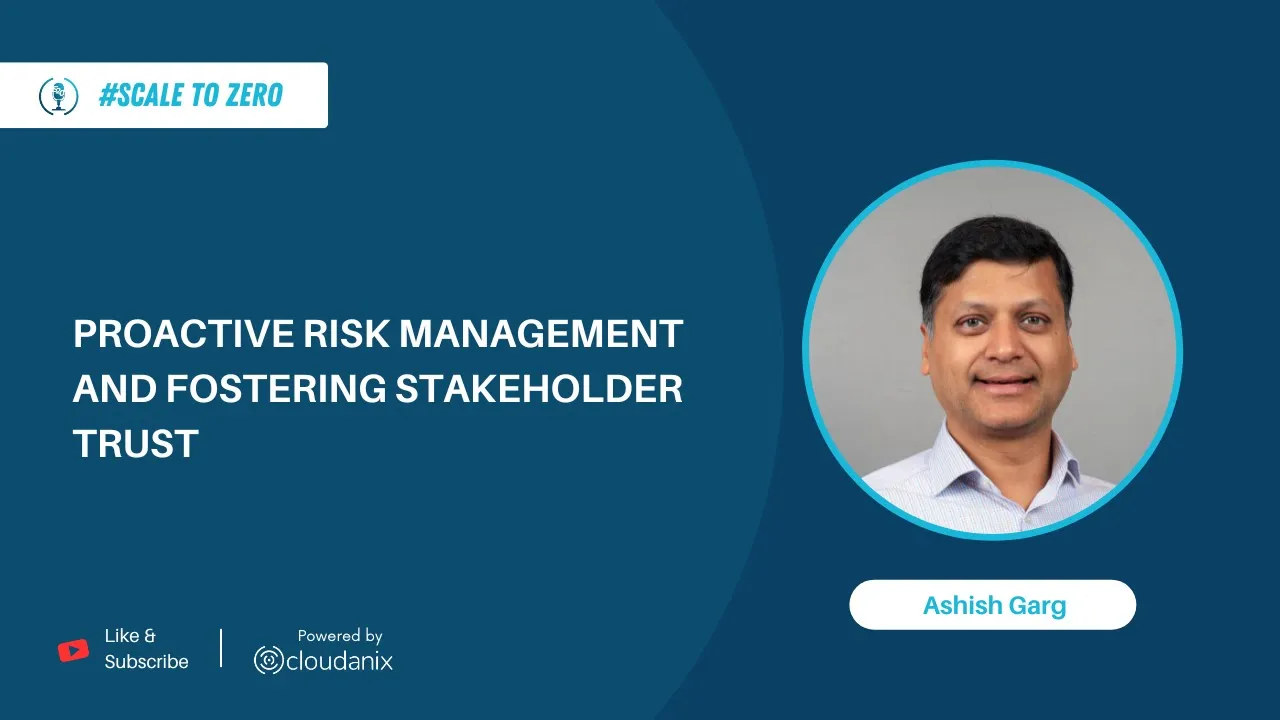In the complex landscape of modern enterprises, security often finds itself at a perennial crossroads: essential yet perpetually under-resourced, recognized yet frequently seen as a bottleneck. To truly scale security to zero friction, the mindset must shift from viewing it as a cost center to recognizing it as an engine of business value.
We recently hosted Ashish Garg, Founder of RIGA Cyber, who is also a globally recognized leader in cybersecurity and AI security, on the ScaleToZero podcast to discuss this very transformation. Drawing from his unique journey—starting as an engineer and R&D scientist building security products for a decade, then transitioning to a practitioner role building and maturing security programs—Ashish provided actionable strategies for fostering stakeholder trust, building proactive risk management programs, and navigating the emerging challenges of AI security.
You can read the complete transcript of the epiosde here >
The central theme of our conversation was clear: security must be a shared responsibility. For leaders who never have all the budget or resources they need, the challenge is one of communication, storytelling, and alignment.
The Art of Executive Communication and Stakeholder Alignment
Ashish stressed that the single most critical factor in bridging the trust deficit between the security team and the rest of the organization—from engineering to the boardroom—is changing the narrative. Security leaders must stop speaking the language of tech and start speaking the language of the business.
Translating Technical Risk into Business Risk
When communicating up the chain, time is short, and the stakes are high. The goal is to articulate the value of the security program clearly.
- Quantify the Impact in Dollars: Executives care about dollars and business impact. Ashish advises translating complex technical vulnerabilities into clear business risk scenarios. Instead of discussing high vulnerability counts, explain that a specific vulnerability could lead to a $5 million loss within a day. Conversely, show that a $200,000 investment in tooling can drastically reduce that risk and potentially prevent the breach.
- Focus on Business Continuity: Security is an enabler of innovation and a crucial component of business continuity. The discussion shouldn’t just be about spending but about avoiding business interruptions and protecting brand trust. Ashish highlighted that recovery costs, potential fines from non-compliance (especially in regulated industries like finance and healthcare), and reputational damage are all metrics that resonate deeply in the boardroom.
- Simplify the Complex: The principle here is to speak to the language of your audience. Ashish quoted Mark Twain to emphasize the effort required: “I did not have time to write you a short letter, so I wrote you a long letter”. Simplifying complex concepts—such as explaining a lack of a ransomware program means you have no backup systems, recovery plan, or secondary data site—makes the risk tangible and measurable. He suggested using common human language, like red, green, and yellow, in slides for easy understanding.
The Power of Collaboration with Engineering
Bridging the gap with engineering and product teams—often the perceived source of friction—requires building trust and acting as a partner, not a blocker.
- Shift Left, Get Early: Ashish’s firm belief is that the earlier you get involved, the better. Getting involved just before release for a security review is stressful and inefficient.
- Share the Roadmap: A core strategy Ashish employed was holding regular meetings with stakeholders and actually sharing his 18-month to two-year security roadmap. This allowed for proactive alignment, reducing overhead on his team and preventing late-stage conflicts.
- Adopt Their Language: He initiated bi-weekly, non-agenda-driven meetings with his engineering peer, focusing on mutual understanding of what each team was working on. This built organic trust, leading the engineering team to proactively approach security at the start of new projects.
- Enablement over Obstruction: This partnership even led to situations where engineering teams, recognizing the security requirement was crucial for their product’s revenue goal, used their budget to purchase security tools required for the release, viewing it as an enablement cost. This demonstrates that alignment turns security into a genuine shared responsibility.
Proactive Risk Management and Leadership Superpowers
To maintain a proactive security posture, leaders must focus on foundational programs and adopt key leadership principles to avoid burnout and chaos.
The Fundamentals of Proactive Security
Ashish identified several cultural and non-technical hurdles to achieving a proactive posture:
- Asset Management is Foundation: A core, counterintuitive challenge, especially in large enterprises, is a lack of visibility into existing assets. Without comprehensive asset visibility, any security program will be deep but not broad enough to cover all risks.
- Efficacy over Existence: Simply having controls isn’t enough. Proactive security requires continuously checking the efficacy of controls—whether they are working as expected—and ensuring they evolve with the business landscape.
- Training and Incident Response: Proactive defense includes regular training, awareness, and conducting tabletop exercises. Having clear roles and responsibilities defined before an incident occurs prevents scrambling and chaos.
- SDLC Integration: For organizations that build code, integrating security scans early in the SDLC process is essential to reduce the risk of deploying vulnerable products.
Leadership Superpowers in Chaos
Running a business or leading a large security organization can feel chaotic, demanding, and often lead to burnout. Ashish offered two crucial pieces of advice for security leaders to manage this:
- Protect Your Time: The higher up you go, the more senior you become, the more crucial it is to protect your time. Trying to do everything yourself is a sure path to burning out quickly.
- Prioritize and Delegate: Leaders must first identify what only they can do really well. The tasks they are not skilled at—the ones that require learning under a deadline—should be delegated. Learning to prioritize and delegate effectively is the most important skill to combat burnout.
The Future: AI Security and the Mentorship Mindset
The conversation concluded by looking at the seismic shift brought by AI and the foundational role of mentorship in preparing for it.
Navigating the AI Security Landscape
Ashish noted that many companies are currently under pressure to adopt AI without fully understanding the defined business case, often deploying products prematurely. The two main AI security trends are:
- Cybersecurity for AI (Protection): This focuses on protecting the AI environment itself, addressing issues like data exfiltration, plagiarism, and vulnerabilities within LLM models. Ashish believes this area will quickly see an increase in regulations and compliance standards to bring all companies to a baseline level of security.
- AI for Cybersecurity (Offense/Defense): This is where AI’s greatest value lies, particularly on the incident response side. AI will be used to enrich data and automate initial analysis, potentially replacing or augmenting Level 1 SOC analysts. Ashish’s “dream” is to see an AI-driven system that provides automatic network segmentation and an AI-driven Zero Trust model that blocks access based on behavioral analysis, solving massive operational scaling issues for enterprises.
Mentorship as a Leadership Tool
Ashish, who is passionate about both mentoring and receiving mentorship, views the mentorship mindset as a direct tool for security leadership.
The core function of a mentor is to simplify complex tasks and remove intellectual chaos. This is exactly what a leader does for the board: simplifying the complex concept of cybersecurity into clear business risks.
By adopting this mindset, leaders can:
- Empower Stakeholders: Empower the board and teams with knowledge about current trends, such as the rapid pace of change in AI.
- Promote Generalism: Prepare their teams for a future where generalists will be more successful than specialists because they must know more about a wider array of technologies and risks.
- Foster Collaboration: Use the principle of collaboration to encourage teams to interact, avoid duplicating work, and leverage each other’s complementary skills.
In closing, Ashish’s insights confirm that the future of cloud security leadership is about being the glue or the lubrication—the strategic link that ensures technical teams and business goals are working seamlessly and effectively together.
We believe that by adopting these strategies, every security leader can not only transform their own program but also build an organization where security is seamlessly embedded, enabling innovation while maintaining continuity.

